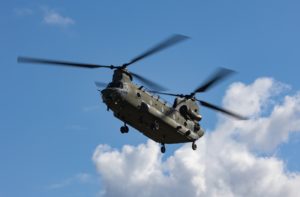
Year: 2020, 2021, and 2025
Market size: $50.75 billion, $52.27 billion, and $67.5 billion, respectively
Today’s market size shows total global revenues for military helicopters in 2020, estimated for 2021, and projected for 2025.1 Helicopters were first conceived by Leonardo da Vinci in 1486 but Igor Sikorsky invented the first practical and working helicopter. The first tethered flight took place on September 14, 1939, in Stratford, Connecticut. The first free flight happened on May 13, 1940.2
Nearly 4 years later, on April 25, 1944, the first U.S. helicopter flew in combat. The YB-R4, a modification of Sikorsky’s R-4, was used to rescue 4 men who crash-landed behind enemy lines in Burma. During the Korean War, helicopters were used for observation and for evacuating wounded soldiers from the front lines. During the Vietnam War, all branches of the military used helicopters. They were used for the movement of troops and supplies, medical evacuations, scouting, and providing air support for troops on the ground. Helicopters proved invaluable for moving troops and supplies quickly as Vietnam had no developed network of roads and the jungles and mountains were difficult to access. The “Huey”, the Army’s UH-1 “Iroquois”, is one of the most recognized images of the war, logging more than 10 million flight hours in Vietnam. Nearly 5,000 U.S. helicopter pilots and crewmembers died conducting aerial operations in Southeast Asia during the war. On April 18, 2018, the Vietnam Helicopter and Crewmember Monument was dedicated at Arlington National Cemetery.
Currently, there are 7 types of helicopters used by the military. Attack helicopters can reach high speeds and are heavily armed with autocannons, machine guns, rockets, and missiles. They are specifically designed for firing on enemy troops and vehicles. Search and rescue helicopters are durable and agile and contain sophisticated avionics and radar systems to navigate all types of terrain and weather conditions. They are also equipped with self-defense systems such as infrared jammers and laser detection systems. Some also have warfare armaments. Transport helicopters are designed to carry a large number of troops, light vehicles, and cargo near the battlefield. These helicopters are also designed to be quick. In the U.S. the most recognizable transport helicopter is the Boeing CH-47 Chinook, which can travel at a maximum speed of nearly 200 mph. Observation helicopters are used for intelligence gathering and reconnaissance. They have high-tech sensors and communications equipment, infrared cameras, low-light-level televisions, and multifunctional laser systems for range-finding or targeting. With the intelligence gained, the crew can call in or direct airstrikes and guide anti-tank missiles or laser-guided bombs fired from other aircraft. Utility helicopters perform a variety of tasks that all the previously mentioned specialized helicopters can perform from conducting ground attacks to air assault, reconnaissance, troop and equipment transport, and medical evacuations. The Sikorsky UH-60 Black Hawk and the Huey are examples of utility helicopters. Maritime helicopters are newer. They were developed to support naval missions including search and rescue, surveillance, and anti-submarine warfare. Multi-role helicopters are used by several branches of the military for a variety of missions. They’re used for rescue, medical evacuation, and recovery missions in inhospitable environments. The Boeing AH-64 Apache is an example of a multi-role helicopter. The U.S. Army uses it for precision strike and armed reconnaissance missions in all weather conditions.In 2020, heavy-lift military helicopters, those weighing over 50,000 pounds maximum gross weight,3 held the highest share of the market at 39.1%. Light military helicopters, those weighing less than 12,000 pounds maximum gross weight, are expected to be the fastest-growing segment with anticipated annual sales growth of $3.98 billion through 2025. Sales of assault/attack helicopters are expected to rise by $2.68 billion by 2025.
The Asia-Pacific region held the highest revenue share, 30.8%, in 2020. North America ranked second. The regions with the fastest revenue growth through 2025 are expected to be Eastern Europe, with a compound annual growth rate of 7.4%, followed by the Asia-Pacific region (+6.1%), Western Europe (+5.17%), and the Middle East (+4.7%). In the United States, annual sales are expected to increase by almost $2.1 billion by 2025.
The global military helicopter market is concentrated with the top 10 companies accounting for 72.15% of the market in 2020. These include The Boeing Co. with a 14.76% share, followed by Airbus (12.45%), Russian Helicopters (10.13%), Lockheed Martin (8.99%), Leonardo SpA (6.20%), China Aerospace Science and Industry Corp. (5.34%), Textron Inc. (4.35%), Raytheon Technologies (4.12%), BAE Systems (3.94%), and Hindustan Aeronautics Ltd. (1.88%).
1 The report from which these numbers were taken was published before the United States ended its military operations in Afghanistan. It remains to be seen how this will affect the projections for 2025.2 His first practical helicopter, the VS-300A, is currently on exhibit at The Henry Ford in Dearborn, Michigan.
3 In the U.S. Army, the term “heavy-lift” is reserved for helicopters that are greater than 80,000 pounds maximum gross weight.
Sources: “Military Helicopters Market Size, Share 2021 and Forecasts by TBRC,” Intrado Globenewswire, August 31, 2021 available online here; “Military Helicopters Global Market Report 2021: COVID 19 Impact and Recovery to 2030,” The Business Research Company, Report Description, January 2021 available online here; “World’s First Helicopter — Today in History: September 14,” ConnecticutHistory.org, September 14, 2018 available online here; “History of Helicopters,” available online here; “First Combat Helicopter,” History available online here; Otto Kreisher, “Rise of the Helicopter During the Korean War,” HistoryNet, January 16, 2011 available online here; “Featured Topics: Helicopters,” Vietnam Veterans Memorial Fund available online here; “World Wide Helicopters,” GlobalSecurity.org, September 20, 2013 available online here; “1939 Sikorsky VS-300A Helicopter,” The Henry Ford available online here; Talal Husseini, “Advanced Military Helicopters: How Function Dictates Capability,” Airforce Technology, April 17, 2019 available online here; “The 7 Types of Military Helicopters (with Examples),” AeroCorner, July 31, 2019 available online here.
Image source: TheOtherKev, “chinook-helicopter-6196472,” Pixabay, April 26, 2021 available online here.
